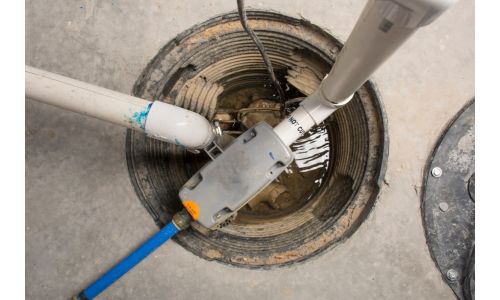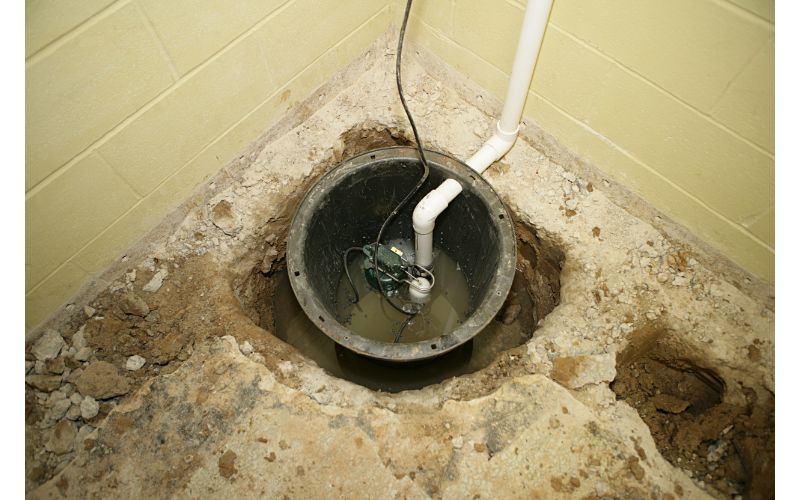A sump pump is essential for keeping your basement dry and preventing water damage. However, the discharge pipe that directs the water away from your home’s foundation can be unsightly and disrupt your outdoor space. So, how to hide sump pump discharge pipe? Follow any of these methods to hide it to give your surroundings a tidy look.
- Extend the discharge pipe
- Natural Barrier With Planting
- Create a Rock Bed or Gravel Trench
- Painting or Camouflage
- Incorporate the Pipe into Landscaping Features. Etc.
In this article, we’ll explore several creative and practical methods to effectively hide the sump pump discharge pipe while maintaining its functionality. Stay tuned!
Materials Needed To Hide Sump Pump Discharge Pipe
To hide a sump pump discharge pipe effectively, you will require the following necessary tools.
- Shovel or Trenching Tool
- Saw
- Landscape Fabric
- Level and Measuring Tape
- Pipe Extensions
- Check Valve
- Decorative Covers
- Paintbrush or Roller
- Screws or Fasteners
- Plant
- Wood
- Clear coat
How to Conceal The Sump Pump Discharge Pipe?
Here are some of the adequate methods to effectively conceal the Sump pump discharge pipe with a step-by-step process.
Method 1: Underground Pipe Extension
Use a solid PVC pipe to prevent clogging and ensure smooth water flow. The pipe is buried at least 10 feet away from your home’s foundation, sloping it away from the house. The endpoint should direct the water toward a natural drainage area or a designated storm water management system.

Step-by-step process:
Carefully follow the step-by-step process below.
Step 1: Find the sump pump basin and pipe: Near the sump pit in your basement, you’ll locate the sump pump basin and the pipe extending from the sump pump.
Step 2: Excavate a trench: Dig a trench from the sump pump discharge pipe to the chosen concealment spot. Ensure ample depth for pipe accommodation and adequate drainage.
Step 3: Establish the underground pipe extension: Connect the trench securely to the sump pump discharge pipe using suitable fittings and connectors.
Step 4: Conceal the pipe: Place the connected pipe in the trench and cover it with soil. Compact the soil carefully to avoid future settling or pipe damage.
Step 5: Extend the pipe to proper drainage: Bury the pipe until it reaches a suitable area like a downhill slope or designated system. This is to ensure an effective water discharge away from the foundation.
Step 6: Conduct a system test: After completing the project, run a test. This is to ensure that the sump pump is discharging water properly through the extended pipe and that there are no leaks or blockages.
Watch this video showing the best practice to hide a sump pump discharge pipe
Method 2: Create a Rock Bed or Gravel Trench
For a natural and attractive camouflage, consider creating a rock bed or gravel trench along the path of the discharge pipe.
Dig a shallow trench and fill it with decorative rocks or gravel for a pleasing appearance. This not only helps disperse the water and prevent erosion but also effectively hides the pipe in plain sight.
Method 3: Natural Barrier With Planting
Strategically plant shrubs, bushes, or tall grasses around the discharge area to help conceal the pipe naturally. Choose plants with dense foliage that grows to create a natural barrier, effectively camouflaging the pipe.
In this case, evergreen plants are particularly suitable, as they maintain their lush appearance throughout the year. Just clear debris and weeds around the sump pump discharge pipe. Then, create a trench or raised bed for planting. Trim as needed to avoid obstructing the sump pump discharge pipe.
Method 4: Landscape Feature
Incorporate the discharge pipe into a landscaped feature. For example, you’ll build a small waterfall, rock garden, or flower bed around the pipe. Integrating the pipe into the design of your landscape helps it blend in naturally.
Method 5: Painting or Camouflage
If the discharge pipe is above ground and made of a material like PVC, consider painting it to match your landscape or the exterior of your home. Alternatively, make use of camouflage techniques, such as wrapping the pipe with outdoor fabric that matches the surroundings.
Step-by-step process
To hide a sump pump discharge pipe using painting or camouflage, here is a step-by-step process:
Step 1: Assemble the required materials: sandpaper, spray paint, leaves, a painting item (like an ammo can), primer, and a clear coat.
Step 2: Clean the pipe: Thoroughly clean the surface of the sump pump discharge pipe to remove any dirt, debris, or loose paint.
Step 3: Preparing the pipe: Prime the pipe’s surface with a paintbrush to facilitate improved paint adhesion and better coverage to create a polished finish.
Step 4: Painting the pipe: Paint with either a paintbrush or a roller to coat the pipe with the chosen paint color. Also, apply 2-3 coats, allowing each layer to fully dry before proceeding with the next application.
Step 5: Conceal the pipe: Explore the option of using furniture for temporary pipe concealment. Verify that the furniture arrangement does not obstruct vents or impede the sump pump’s functionality.
Method 6: Underground Drainage System
Consider installing an underground drainage system to direct the water away from the house. This system includes perforated pipes buried beneath the ground, allowing water to seep into the soil gradually.
Method 7: Discharge Pipe Cover
Invest in a specially designed discharge pipe cover or box that blends well with your outdoor environment. These covers are available in various materials, including plastic and faux rocks.
Make sure the cover allows for proper ventilation and doesn’t obstruct water flow. Use a discharge pipe cover to hide your sump pump discharge pipe.
Steps to follow:
Step 1: Take measurements of the discharge pipe’s diameter and length to find a well-fitting cover.
Step 2: Select a suitable cover that complements the surroundings and safeguards the pipe.
Step 3: Slide the cover onto the discharge pipe and secure it as per the manufacturer’s instructions.
Step 4: Properly seal the cover to prevent water leakage and potential damage.
Step 5: Regularly inspect the cover for wear or damage, replacing it as needed to ensure continued effectiveness.
Method 8: Temporary Concealment with Furniture
This method is easy and convenient, letting you hide the pipe in your yard without permanently changing the landscape. Here’s how:
- Pick suitable furniture like a chair or couch to hide the pipe.
- Place the furniture over the sump pump discharge pipe, securing it so it doesn’t block drainage or the pump’s function.
- Enhance concealment with outdoor cushions or pillows on the furniture. Select colors and patterns that complement the landscape for a cohesive and appealing look.
Tips for Hiding Sump Pump Discharge Pipe
Here are some additional tips to help you successfully hide your sump pump discharge pipe.
- Research local building codes and regulations
- Select a suitable location
- Opt for quality materials
- Use PVC cement properly
- Slope the trench appropriately
- Consider a pop-up emitter
- Use suitable landscaping fabric
- Select rocks or mulch that complement your landscape design.
- Avoid planting aggressive plants
- Regularly inspect and test the system
- Monitor during heavy rainfall
Safety Precautions
To achieve a secure and efficient installation while concealing a sump pump discharge pipe, remember these vital precautions.
- Avoid blocking access to the sump pump
- Use proper pipe materials
- Proper water redirection from structures
- Avoid sharp bends and kinks
- Consider freezing temperatures
- Check for leaks.
Frequently Asked Questions
Here are some questions people also ask about how to hide a sump pump and answers to them.
Q: What are the benefits of burying the pipe underground?
Burying the pipe prevents it from being a trip hazard and provides a more seamless and natural-looking concealment.
Q: How long is furniture suitable for the temporary concealment of a sump pump discharge pipe?
With proper care and maintenance, furniture is used for temporary concealment for a few months to a couple of years.
Q: What is a Lawnscape Outlet?
A Lawnscape Outlet serves as a great solution for terminating a sump pump discharge line in a sloped yard. Its grated design ensures debris stays out of the pipe.
Final Words
Concealing a sump pump discharge pipe offers a practical and aesthetically pleasing method to enhance your property’s appearance. Also, it helps to efficiently manage water drainage. You will achieve the best results and ensure a smooth installation process by following the step-by-step guide tips and precautions.
However, if you need clarification on any aspect of the project or encounter difficulties, consider consulting with a professional landscaper or plumber. They can provide expert guidance and ensure a successful and smooth outcome.

